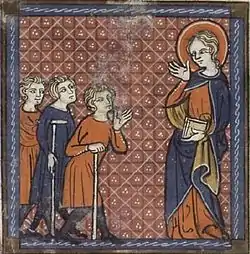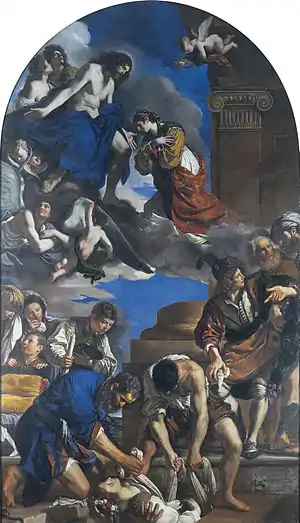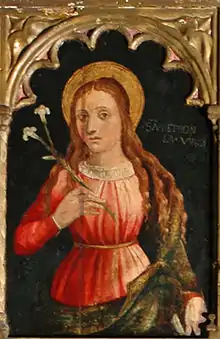Saint Petronilla
Saint Petronilla (Aurelia Petronilla[1]) is an early Christian saint. She was venerated as a virgin martyr by the Catholic Church. She died in Rome at the end of 1st century, or possibly in the 3rd century.
Saint Petronilla | |
|---|---|
 Saint Petronilla and the Sick. 14th-century French manuscript. | |
| Died | 1st century; possibly 3rd century |
| Venerated in | Roman Catholic Church |
| Feast | 31 May |
| Attributes | Depicted being healed by Saint Peter the Apostle; early Christian maiden with a broom; lying dead but incorrupt in her coffin with flowers in her hair as the coffin is opened during renovations; receiving the newly dead into heaven; set of keys; spurning a marriage proposal, represented by a ring, being offered by a king; standing with Saint Peter; woman holding a set of keys; woman with a dolphin |
| Patronage | The dauphins of France; mountain travellers; treaties between Popes and Frankish emperors; invoked against fever |
Identity
Petronilla is traditionally identified as the daughter of Saint Peter, though this may stem simply from the similarity of names. It is believed she may have been a convert of the saint (and thus a "spiritual daughter"), or a follower or servant.[2] It is said that Saint Peter cured her of palsy.
Roman inscriptions, however, identify her simply as a martyr. She may have been related to Saint Domitilla.
Stories associated with her include those that relate that she was so beautiful that Saint Peter had locked her up in a tower to keep her from eligible men; that a pagan king named Flaccus, wishing to marry her, led Petronilla to go on a hunger strike, from which she died.
In the 4th-century Roman catalogue of martyrs' feasts, which is used in the Martyrologium Hieronymianum, her name seems not to have been inserted. It occurs in the latter martyrology,[3] but only as a later addition. Her name is given under 31 May and the Martyrologies of Bede and his imitators adopt the same date.[4]
The absence of her name from the 4th-century Roman calendar of feasts suggests that Petronilla died at the end of the first or during the 2nd century, since no special feasts for martyrs were celebrated during this period. After the erection of the basilica over her remains and those of Sts. Nereus and Achilleus in the 4th century, her cult extended widely and her name was therefore admitted later into the martyrology. A legend, the existence of which in the 6th century is proved by its presence in the list of the tombs of the Roman martyrs prepared by Abbot John at the end of this century,[5] regards Petronilla as a real daughter of Saint Peter. In the Gnostic apocryphal Acts of St. Peter, dating from the 2nd century, a daughter of St. Peter is mentioned, although her name is not given.[6]
The legend being widely propagated by these apocryphal Acts, Petronilla was identified at Rome with this supposed daughter of St. Peter, probably because of her name and the great antiquity of her tomb. As such, but now as a virgin, not as a martyr, she appears in the legendary Acts of the martyrs St. Nereus and Achilleus and in the Liber Pontificalis. From this legend of Sts. Nereus and Achilleus a similar notice was admitted into the historical martyrologies of the Middle Ages and thence into the modern Roman Martyrology.[7]
Veneration

Burial
Almost all the 6th- and 7th-century lists of the tombs of the most highly venerated Roman martyrs mention St. Petronilla's grave as situated in the Via Ardeatina near Sts. Nereus and Achilleus.[8] These notices have been completely confirmed by the excavations in the Catacomb of Domitilla. One topography of the graves of the Roman martyrs, Epitome libri de locis sanctorum martyrum, locates on the Via Ardeatina a church of St. Petronilla, in which Sts. Nereus and Achilleus, as well as Petronilla, were buried.[9]
This church, built into the above-mentioned catacomb, has been discovered, and the memorials found in it removed all doubt that the tombs of the three saints were once venerated there.[10]
A painting, in which Petronilla is represented as receiving a deceased person (named Veneranda) into heaven, was discovered on the closing stone of a tomb in an underground crypt behind the apse of the basilica.[11] Beside the saint's picture is her name: Petronilla Mart. (yr). That the painting was done shortly after 356, is proved by an inscription found in the tomb.
It is thus clearly established that Petronilla was venerated at Rome as a martyr in the 4th century, and the testimony must be accepted as certainly historical, notwithstanding the later legend which recognizes her only as a virgin (see below). Another known, but unfortunately no longer extant, memorial was the marble sarcophagus which contained her remains, under Pope Paul I translated to St. Peter's Basilica. In the account of this in the Liber Pontificalis the inscription carved on the sarcophagus is given thus: Aureae Petronillae Filiae Dulcissimae ("of the golden Petronilla, the sweetest daughter"). The sarcophagus was discovered, in the very chapel dedicated to her in Old St Peter's, under Pope Sixtus IV, who hastened to inform Louis XI of France.[12] Extant 16th-century notices concerning this sarcophagus assert that the first word was Aur, (Aureliae), so that the martyr's name was Aurelia Petronilla. The second name comes from Petro or Petronius, and, as the name of the great-grandfather of the Christian consul, Titus Flavius Clemens, was Titus Flavius Petro, it is very possible that Petronilla was a relative of the Christian Flavii, who were descended from the senatorial family of the Aurelii. This theory would also explain why Petronilla was buried in the catacomb of the Flavian Domitilla. Like the latter, Petronilla may have suffered during the persecution of Domitian, perhaps not till later.[7]

Chapel of St Petronilla
In 757 the coffin containing the mortal remains of the saint was transferred to an old circular building (the mausoleum of Emperor Honorius[13][14] dating from the end of the 4th century) near Old St Peter's. This building was altered and became the Chapel of St Petronilla.[7]
Her chapel became the burial place for French kings.(Reference? Most French kings were buried in Saint-Denis...) Her association with the French crown stems from the fact that Charlemagne and Carloman were considered Saint Peter's adopted sons after 800. Petronilla, as the supposed daughter of Peter, became their patroness and of the treaties concluded between the Holy See and the Frankish emperors.
When St Peter's was rebuilt in the 16th century, the old chapel and former mausoleum was demolished[13][15] and Saint Petronilla's relics were translated to an altar dedicated to her in the upper end of the right side-aisle of the new basilica (near the cupola). The chapel includes embellishments by Michelangelo and Bramante.
Guercino painted an altarpiece called The Burial of Saint Petronilla in 1623. It simultaneously depicts the burial and the welcoming to heaven of the martyred Saint Petronilla. The altar is dedicated to the saint, and contains her relics.
Her feast falls on 31 May. Mass on this day in St. Peter's is offered for France and attended by French residents of Rome.
She is patroness of the dauphins of France because a dolphin (in French, dauphin) was reputedly found carved on her sarcophagus.[16]

Ambrogio Lorenzetti painted a Santa Petronilla Altarpiece in the 1340s. The Healing of St Petronilla is the name of a tapestry made for Guillaume de Hellande, Bishop of Beauvais, in the 15th century.[17]
St Petronilla's , Whepstead
The only Anglican church dedicated to Petronilla is the parish church of the village of Whepstead in Suffolk.[18] At the time of the English Reformation part of the income of the leper hospital of St Petronilla in Bury St Edmunds came from its holdings in Whepstead, which may explain the village's unusual dedication.[19]
See also
- Saint Petronilla, patron saint archive
Notes
- name variants include Pernelle; Peroline; Perrenotte; Perrette; Perrine; Perronelle; Petronella; Peyronne; Peyronnelle; Pierrette; Pérette; Périne; Pétronille
- "Archived copy". Archived from the original on December 18, 2006. Retrieved November 3, 2006.CS1 maint: archived copy as title (link)
- De Rossi-Duschesne, Martyrologium Hieronymianium, p. 69
- Quentin, Les martyrologes historiques, Paris, 1908, 51, 363, etc.
- De Rossi, Roma sotterranea, I, 180
- Schmid, "Ein vorirenöische gnostisches Originalwerk in koptischer Sprache" in Sitzungsber. der Berliner Akademie, 1896, 839 sqq.; Lipsius, Die apokryphen Apostelgeschichten u. Apostellegenden, II, i, Brunswick, 1887, 203 sqq.
- Kirsch 1911
- Giovanni Battista De Rossi, Roma sotterranea, I, 180–1
- De Rossi, loc. cit., 180
- De Rossi in Bollettino di archeologia cristiana, 1874 sq., 5 sqq.
- Wilpert, Die Malereien der Katakomben Roms, Freiburg, 1903, plate 213; De Rossi, ibid., 1875, 5 sqq.
- Roberto Lanciani, Storia degli scavi di Roma, vol. I:79, noted in Roberto Weiss, The Renaissance Discovery of Classical Antiquity, 1969:102.
- "The Roman Imperial Mausoleum in Late Antiquity - Cambridge University Press". www.cambridge.org. Retrieved 2020-04-16.
- Pearse, Roger (2014-05-16). "Old St Peters, the Circus of Caligula and the Phrygianum". Roger Pearse. Retrieved 2020-04-16.
- Roger Pearse (16 May 2014). "Old St Peters, the Circus of Caligula and the Phrygianum". Roger Pearse's blog. Retrieved 1 December 2015.
- Marthe Crick-Kuntziger, "A Fragment of Guillaume de Hellande's Tapestries," The Burlington Magazine for Connoisseurs, Vol. 45, No. 260. (Nov., 1924), pp. 224–227+230–231.
- "Church of England Saint dedications - St Petronilla".
- "St Petronilla, Whepstead, Suffolk". The Corpus of Romanesque Sculpture.
References
 This article incorporates text from a publication now in the public domain: Kirsch, Johann Peter (1911). "St. Petronilla". In Herbermann, Charles (ed.). Catholic Encyclopedia. 11. New York: Robert Appleton Company.
This article incorporates text from a publication now in the public domain: Kirsch, Johann Peter (1911). "St. Petronilla". In Herbermann, Charles (ed.). Catholic Encyclopedia. 11. New York: Robert Appleton Company.